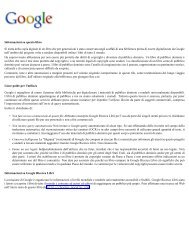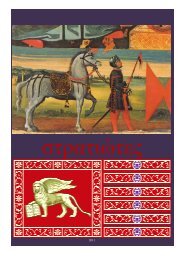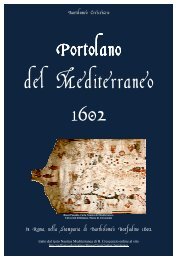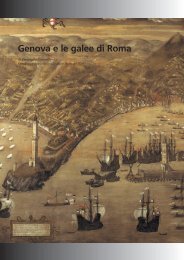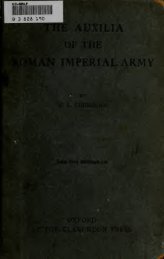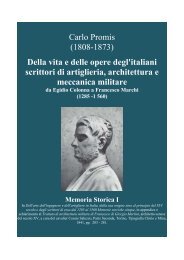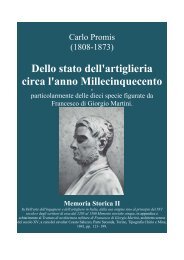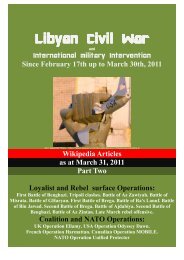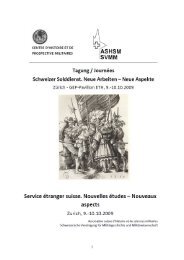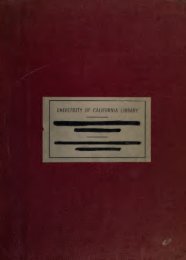United States Army Headgear 1855-1902 - Libreria Militare Ares
United States Army Headgear 1855-1902 - Libreria Militare Ares
United States Army Headgear 1855-1902 - Libreria Militare Ares
- No tags were found...
Create successful ePaper yourself
Turn your PDF publications into a flip-book with our unique Google optimized e-Paper software.
70 SMITHSONIAN STUDIES IN HISTORY AND TECHNOLOGYDevices.—Devices for staff and staff corps to be of Germansilver, according to patterns. Designs as mentioned in descriptionof eagle, and stems as for numbers.Scrolls and Rings (Mounted Troops).—Scrolls and rings.One on each side, between the leaf-shaped points of the toppiece, its lower edge one-half (J/a") inch below these points.The scroll is three-fourths (Yt") diameter, ornamentedto correspond with the fastening of the top piece. On thetop of the scroll, in the center, is an eye of thin wire threesixteenths(%6") of an inch high holding a thin brass ringone-half (Yz") inch in diameter, to keep the cords and bandsin position. The stem of the scroll is formed of two pieces ofthin brass wire to fasten it at the inside of helmet. All tobe high brass.Adopted April 21, 1882, in lieu of specifications No. 8, ofBook of Specifications, and conforming to standard samplesthis day adopted.35. Q.M.G.O., 1882G & Eq.:Supplemental.[Signed] RUFUS INGALLS,Quartermaster General,Bvt. Major General, U.S.A.When specifications were published in 1892 detailingthe uniform for Indian scouts, the helmetfront plate was to be "the eagle prescribed formounted men with the device (crossed arrows) inlieu of the number." Since the scouts normallyoperated with the cavalry, it seems evident thatthey wore the front plate of that arm with thecrossed arrows as pictured in the specifications onthe shield. The side buttons were also to carry thecrossed arrows.*"One small detail remained. On being queried bythe regimental quartermaster of the 15th Infantry,the General of the <strong>Army</strong> decided that the regimentalstaff officers of artillery and infantry, beingmounted, were to wear the helmet trimmings prescribedfor officers of mounted troops, that is, theplume and cords as opposed to the spike."'Because of the confusion caused by the photographsmade in January and published in the<strong>United</strong> <strong>States</strong> <strong>Army</strong> and Navy Journal, Rogers conceivedthe idea of making "phototypes" of the finallyapproved models to obviate any furthertrouble. This was done and the pictures were distributedto all quartermaster officers and to theheadquarters of military divisions and departmentsand published in that year's Annual Report of theQuartermaster General.''^'Even before a contract was let for the new model,altered 1872 helmets were being sent to subordinateinstallations for issue to "all branches." '^" Thefirst contract for the new helmets was let to Raymoldand Whitlock of New York City, 16,000, untrimmed,at |1.69i/4 each. Horstmann won thecontract for the front plates, side buttons, andwhite metal numbers, while Raymold and Whitlocksupplied the top pieces and spikes.'"* Subsequentcontracts, also with Raymold and Whitlock,dropped the unit price of the untrimmed helmetto $1.39 in 1882 and $1.29 in 1882.'" The initialissue price was set at $1.70 for the basic helmet withthe trimmings additional; varying between foot andmounted troops. The rate of issue was one for thefirst and third years.'"A number of these helmets have been examined,both officers' and enlisted including one officer'ssummer model, and all conform to the specificationswithin allowable tolerances (Figures 48-51).The altered helmets were something else again. Ascan be seen (Figure 52), they were of a distinctlydifferent shape, but, as we know, were issued andpresumably worn. Those examined carried theHorstmann label with "Remodeled 1881" added."'The officer's summer model (Figure 51) is particularlyinteresting in that it is apparently a very earlyone, was made by Allien, is almost identical inshape and construction to that shown in the Allien-Miles Board watercolors and in the helmet photographsmade in December 1880 and reproduced inthe <strong>United</strong> <strong>States</strong> <strong>Army</strong> and Navy Journal; amongits nonregulation trimmings it carries the lion headside buttons which caused some adverse comment.It formerly belonged to Bvt. Maj. Gen. Judson Kilpatrick,a 1861 graduate of West Point. Kilpatrickresigned from the service in 1865 and served as ministerto Chile 1866-1870 and from May 1881 untilhis death there in December of the same year.'"' Thehelmet, which must have been purchased prior tohis departure for South America in May 1881, wasapparently intended to serve as part of a quasidiplomaticuniform.'^ In addition to the lion headside buttons and rear chin chain hook with chain,it carries a regulation 1881 staff front plate (whichwas not authorized for wear on the summer helmet)with two silver stars affixed to the shield and the1881 oak leaf plume or spike base to which is fixeda four inch hexagon metal piece surmounted by aflowing plume of black cock feathers.Due to some confusion as to the proper methodof wearing the helmet cords by mounted individuals,the Headquarters of the <strong>Army</strong> in 1886 prescribedthe following:



